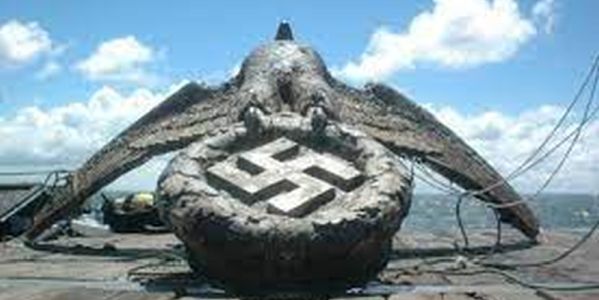 The Battle of the River Plate, fought in the South Atlantic in December 1939 was the first naval battle of the Second World War and ended with the scuttling of the German pocket battleship Admiral Graf Spee. While the battle itself may have ended 84 years ago, the conflict over the fate of the 770-pound bronze eagle, holding a Nazi swastika in its talons, once mounted on the stern of the ship, continues on unabated.
The Battle of the River Plate, fought in the South Atlantic in December 1939 was the first naval battle of the Second World War and ended with the scuttling of the German pocket battleship Admiral Graf Spee. While the battle itself may have ended 84 years ago, the conflict over the fate of the 770-pound bronze eagle, holding a Nazi swastika in its talons, once mounted on the stern of the ship, continues on unabated.
There had been a decades-long three-way legal battle between an Uruguayan businessman who salvaged the eagle, the Uruguayan government, and the government of Germany, which has been concerned that the eagle and swastika will fall into the hands of Nazi sympathizers.
A court ruled last year that it belonged to the Uruguayan state, in whose waters it was found.
In early June, the Uruguayan government finally announced what it would do with the eagle. The country’s president Luis Lacalle Pou proposed melting down the bronze eagle into a sculpture of a dove.
The proposal was not well received.
El Pais reports that a petition was started on change.org in favor of preserving the original eagle, which is over two meters high and weighs 350 kilograms (770 pounds). “It should be kept in a museum. History must be remembered so that the same mistakes are not made again. New generations are prone to forgetfulness and recidivism. Remembering evil and the symbols that represent it is a huge responsibility to society” the petition, which has garnered over 20,000 signatures, read.
Some of the president’s inner circle defended the initiative but they were in a clear minority, as Lacalle Pou later acknowledged. The Vice Minister of Education and Culture and president of the Heritage Commission, Ana Ribeiro, said she had learned about the project from the press. Ribeiro, a renowned Uruguayan historian, is in favor of preserving the eagle. “I would keep it […] I would find it much more educational to make a good museum of the Battle of the River Plate,” she told Radio Sarandí.
Several historians pointed to the significance of the confrontation in the early stages of World War II between the Graf Spee and British Royal Navy ships in the waters of the River Plate. The first naval battle of the war, fought in December 1939, resulted in over a hundred deaths and nearly 90 casualties and the subsequent scuttling of the German ship on the orders of its captain, Hans Langsdorff.
The bronze eagle was salvaged by a team of experts in 2006, giving rise to a legal dispute between the treasure hunters and the Uruguayan authorities. Eventually, Uruguay’s Supreme Court ruled in December 2022 that the eagle was state property.
“The proposal meant that in just 48 hours a debate took place in Uruguay that was positive, and also allowed the president to reverse his decision,” says Emma Sanguinetti, an art critic and cultural manager. The eagle “embodies one of the most fateful moments in human history,” she adds. “History cannot be the object of metamorphosis. Historical objects have the value of leaving the abstract event and passing it to the real. They are an indispensable instrument.” In this sense, Sanguinetti points out that the eagle of the Graf Spee is not a celebratory object and that if transformed it would become something that it never was: a symbol of peace.
In line with her colleagues, Sanguinetti believes it would be best to exhibit the eagle and give it appropriate historical context. “It would be a great opportunity to tell the story of that event, to remind people that this horror reached our shores and that is why the eagle and the swastika are here. The more time goes by, the more the facts become blurred; that is why more history is needed and these objects have greater value.”
Following the controversy generated by his announcement, Lacalle Pou backtracked and acknowledged the proposal went against consensus. ” In the few hours that have passed, an overwhelming majority of people has come forward who don’t share the decision. When you aim for peace, the first thing you need to do is create unity and this clearly didn’t,” he said on Sunday. For now, the eagle of the Graf Spee will remain covered up in an Uruguayan Navy facility. “A symbol of peace and union cannot be born of discord,” added Atchugarry.

I believe that Montivedeo is now the neutral spiritual home of this iconic piece of history where it’s incredible art can be displayed in cognizance of the horrors of the Nazi regime but acknowledging the ignominious end of a fine graceful piece of engineering design and its frailty in the face of the might of the Allies.
I remember being in Montevideo in December 1991 after our historic rounding of Cape Horn when the British registered ships `Soren Larsen` and `Eye of the Wind` afterwards arrived in Montevideo I was then with the `Eye of the Wind` and was one day asked to give a local man a tour of the ship he afterwards asked me to go with him to his museum which was a large collection of items from the `Graf Spee` excellently preserved. If he is still around I would expect him to be one of those pushing for conservation of the eagle which I would whole heartedly agree with. It should also be remembered that the ships commander Lansdorf also became a victim of the Nazi regime of the day he being of the old school of German mariners.